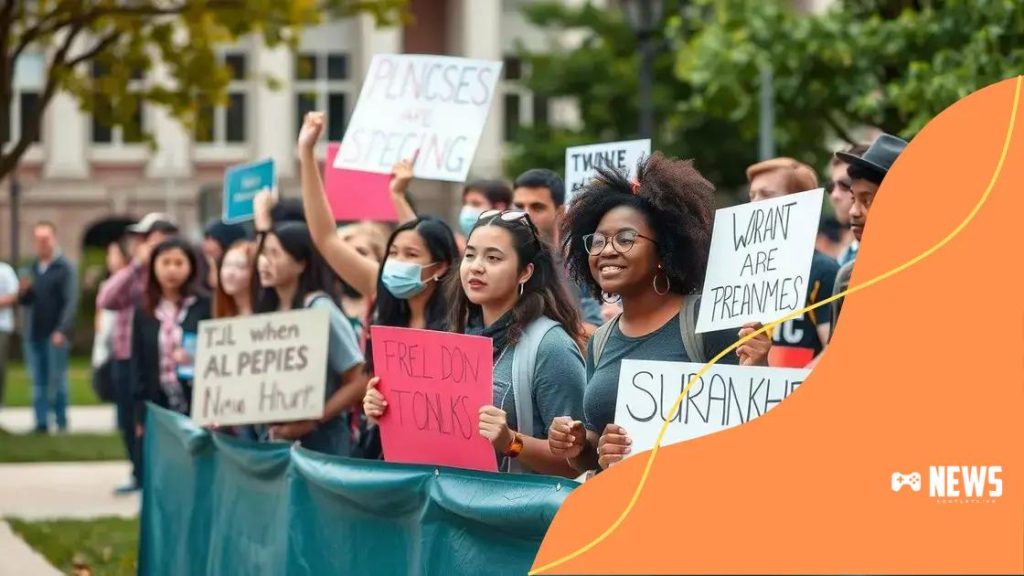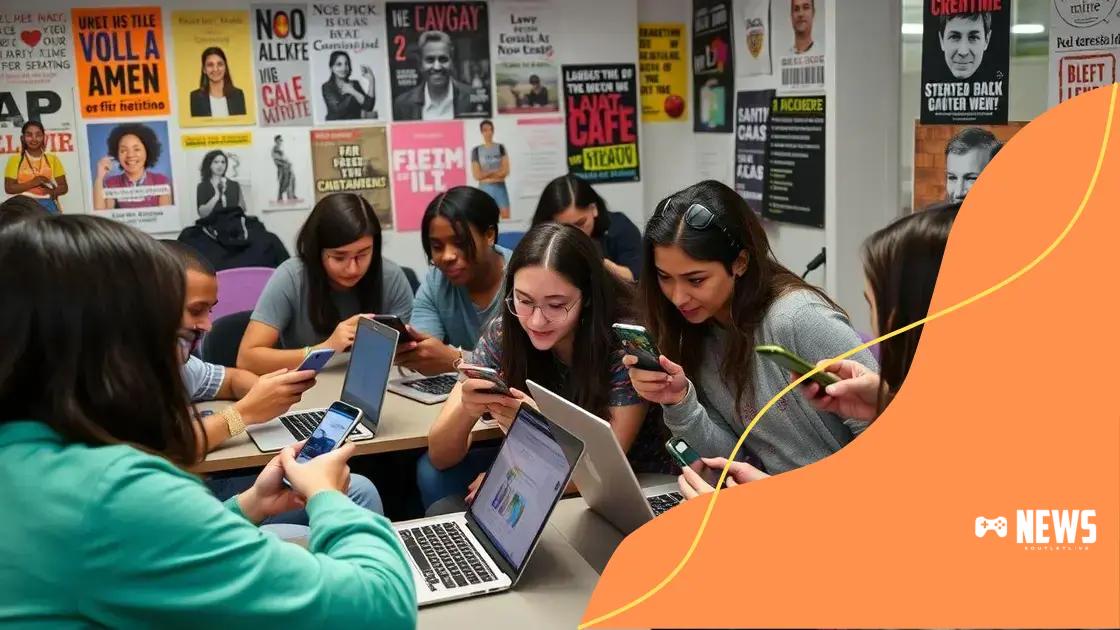Students fight campus censorship in surprising ways

Students fight campus censorship by advocating for free speech, organizing movements through social media, and challenging policies while seeking to create inclusive environments for diverse opinions in educational settings.
Students fight campus censorship in various innovative ways, challenging boundaries and sparking conversations about free speech. How are today’s students making their voices heard against restrictive policies?
Understanding campus censorship
Understanding campus censorship is crucial for students today. This phenomenon occurs when educational institutions impose restrictions on what can be expressed or discussed within their walls. These limits can stifle creativity, debate, and the overall educational experience.
To grasp the impact of censorship, one must consider its various forms, which can be subtle or overt. For example, some schools might limit speakers based on their viewpoints or even restrict the distribution of certain printed materials. Such actions raise questions about the rights of students and the responsibilities of educational establishments.
Common Forms of Censorship
Censorship can manifest in different ways on campuses. Here are some common forms:
- Restricting guest speakers based on controversial topics.
- Prohibiting certain publications from being distributed.
- Limiting protests or demonstrations.
- Implementing strict guidelines on dress code that may suppress personal expression.
Campus censorship is often justified by authorities as a means to promote safety or protect students from potentially harmful ideas. However, many students and advocates believe that these measures can lead to an oppressive atmosphere in which open dialogue is discouraged.
The Importance of Open Dialogue
Promoting open dialogue is vital for a thriving educational environment. When students can openly share ideas, engage in discussion, and challenge each other respectfully, they develop critical thinking and communication skills. These experiences mirror real-world scenarios where diverse opinions clash and must be navigated.
Furthermore, understanding campus censorship allows students to advocate for their rights. By knowing what constitutes free speech and understanding the policies that govern their institutions, they can engage more effectively in discussions about censorship. They can also create movements that push for more transparent and fair practices regarding expression on campus.
Historical examples of student activism
Historical examples of student activism reveal the powerful role that young people play in shaping society. These movements have often sparked significant changes in policies and cultural norms. By examining these moments, we can understand the impact students have had in advocating for their rights and freedoms.
One notable event is the 1960s civil rights movement. College students were at the forefront, organizing sit-ins and protests to demand equality and justice. Their efforts led to crucial legislative changes and inspired future generations to engage in activism.
The Vietnam War Protests
During the Vietnam War, students across the nation voiced their opposition through demonstrations. This period marked a significant rise in organized protests. Many universities held teach-ins, where students learned about the war’s implications. These gatherings were instrumental in rallying public opinion against military involvement.
- Columbia University protests in 1968.
- The Kent State shooting in 1970 led to widespread outrage.
- Campus protests influenced the national discourse on war.
Another significant moment in student activism occurred in the late 1980s. The anti-apartheid movement gained momentum as students across the globe protested against racial segregation in South Africa. U.S. universities participated by divesting from companies operating in South Africa. The combined pressure from students contributed to the eventual end of apartheid.
Modern Movements
In recent years, movements like March for Our Lives have demonstrated how students continue to mobilize for change. Following tragic school shootings, young activists organized rallies to advocate for stricter gun control laws. Their passionate speeches and organized actions have amplified discussions around gun safety legislation.
Furthermore, students have used social media platforms to raise awareness quickly and mobilize support efficiently. Hashtags like #BlackLivesMatter have created a global dialogue about racial justice, illustrating how current students are building on the legacy of past movements.
The role of social media in organizing

The rise of social media has transformed how student activism is organized and amplified. Platforms such as Twitter, Instagram, and Facebook provide students the ability to connect quickly and share information widely. With just a few clicks, a message can reach thousands, inspiring people to participate and mobilize.
Many recent movements have gained momentum through social media campaigns. For example, hashtags like #MeToo and #BlackLivesMatter have created a powerful online community. These movements not only raise awareness but also call for real-world actions, from protests to policy change.
Strategies Used on Social Media
Students utilize various strategies to maximize the impact of their activism online. Some effective methods include:
- Creating eye-catching graphics and videos to share messages.
- Using hashtags to unify supporters and track discussions.
- Hosting live events to engage audiences directly.
- Sharing personal stories to highlight issues and build empathy.
Social media also allows for rapid response to current events. Students can organize protests or campaigns within hours of an incident, showing how technology has accelerated the pace of activism. For instance, after a school shooting, students have used these platforms to gather support and call for legislative changes almost immediately.
While social media is a powerful tool for organizing, it comes with challenges. Misinformation can spread quickly, and it is essential for activists to fact-check their sources. Additionally, online engagement may not always translate to real-life participation. Thus, striking a balance between online activism and offline actions is crucial for effective campaigns.
Overall, the role of social media in organizing movements reflects a new era of activism. Students are leveraging these platforms to connect, share, and inspire action, making a significant impact on the world around them.
Successful case studies of student movements
Successful case studies of student movements illustrate how collective action can lead to significant change. These examples show the determination and creativity of students fighting for their rights, often leading to broader social movements.
One inspiring case is the 2011 protests at the University of California, Berkeley, where students rallied against tuition hikes. They organized sit-ins and marches, which gained media attention and support from local communities. This movement not only resulted in the university freezing tuition for a year but also ignited discussions about student debt nationwide.
The Parkland Students
In the aftermath of the tragic shooting at Marjory Stoneman Douglas High School in 2018, students organized March for Our Lives. This movement quickly gained momentum as young activists traveled to Washington, D.C., and other cities to advocate for stricter gun control measures. They used social media effectively to spread their message and rally support.
- They brought millions together for the March for Our Lives event.
- Students created a powerful platform for sharing stories and personal experiences.
- The movement influenced legislative discussions about gun safety.
Another noteworthy example is the fight against apartheid led by South African students in the 1980s. Students protested against discriminatory policies and pushed for a free and equal education system. Their relentless activism drew international attention, contributing to the eventual dismantling of apartheid and inspiring similar student-led movements globally.
The Impact of the Climate Strikes
In recent years, the Global Climate Strikes, initiated by students like Greta Thunberg, have mobilized millions to address climate change. Students around the world skipped school to participate in demonstrations, demanding government action on environmental issues. This grassroots movement emphasizes how students can influence global policy debates.
They have successfully pressured leaders to prioritize climate action, showcasing the power of youth-led activism. Schools and universities are now more engaged in sustainability practices, illustrating a concrete impact of these movements.
Future implications for free speech on campuses
The future implications for free speech on campuses are a topic of great importance as society evolves. As student activism increases, the conversation around free expression continues to grow. Schools are becoming battlegrounds for the debate over what can be said and who can say it.
One pressing issue is the balance between protecting free speech and ensuring a safe learning environment. Many argue that universities should foster open dialogue, even if it includes controversial opinions. However, others feel that certain speech undermines the safety and inclusion of marginalized groups.
Changing Policies and Regulations
As universities work to navigate these complexities, policies around free speech are changing. Many institutions are reviewing their codes of conduct to find a balance between encouraging diverse viewpoints and preventing hate speech. This evolution in policy can lead to:
- Stricter regulations on what can be expressed during campus events.
- Increased support for free speech advocacy groups.
- Workshops and programs that promote respectful discourse.
- Enhanced dialogue between students of opposing views.
Additionally, the influence of social media cannot be overlooked. With online platforms becoming key tools for communication, the ability to share ideas has expanded. Students can gain support and amplify their voices rapidly, which can lead to significant shifts in campus culture. However, this also means ideas can spread misinformation or incite hostility. Proper education on digital citizenship is essential for future students.
The Role of Education in Promoting Free Speech
Educators also play a vital role in shaping how students understand and engage with free speech. By promoting critical thinking and open discussions, they can help students navigate different opinions respectfully. Classes that focus on ethics and communication can empower students to express themselves while also understanding the impact of their words.
The implications of these changes are far-reaching. As students advocate for their rights and express their opinions more than ever, campuses could become more dynamic, with a stronger focus on free speech. However, this will require commitment from both students and administrators to ensure that all voices can be heard while promoting a safe and inclusive environment.
FAQ – Frequently Asked Questions about Free Speech on Campuses
What is the significance of free speech on college campuses?
Free speech fosters a vibrant exchange of ideas, promoting critical thinking and diverse perspectives among students.
How do student movements influence campus policies?
Student movements raise awareness about important issues, often leading to changes in policies that support free expression and inclusivity.
What role does social media play in organizing protests?
Social media allows students to quickly mobilize support, share information, and amplify their messages to a wider audience.
How can universities balance safety and free speech?
Universities can promote a safe environment while allowing free speech by implementing clear policies, encouraging respectful dialogue, and supporting educational programs.





